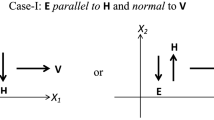Abstract
The purpose of the present study was to estimate storage and loss moduli of an electromagnetic rheological (EMR) fluid in frequencies higher than 100 rad/s. In rotational rheometers, the maximum applicable frequency by the rheometer is 100 rad/s. On the other hand, the required frequency range in various applications of EMR is much higher than this frequency. Therefore, it is necessary to determine rheological properties of smart fluids in frequencies higher than 100 rad/s. The used smart fluid is a magneto-rheological (MR) fluid with the commercial name of MRHCCS4-A. First, using a rotational rheometer, storage and loss moduli in frequencies lower than 100 rad/s were measured. Then, Fredholm integral equations of the first kind and Tikhonov regularization were employed to estimate the relaxation spectrum values. Here, three optimization methods, including imperialist competitive algorithm, genetic algorithm, and particle swarm optimization, have been used. Finally, available analytic correlations were used to estimate the storage and loss moduli in frequencies higher than 100 rad/s. To validate the optimization methods, the numerical results of storage and loss moduli (for frequencies lower than 100 rad/s) were compared with the ones of rheology test. Good agreement between numerical and test results was noticed.
















Similar content being viewed by others
References
Chaudhuri A, Wereley NM, Radhakrishnan R, Choi SB (2006) Rheological parameter estimation for a ferrous nanoparticle-based magnetorheological fluid using genetic algorithms. J Intell Mater Syst Struct 17:261–269
Gandhi F, Bullough WA (2005) On the phenomenological modeling of electrorheological and magnetorheological fluid preyield behavior. J Intell Mater Syst Struct 16:237–248
Jolly MR, Nakano M (1998) Properties and applications of commercial controllable fluids. In: Sixth International Conference on New Actuators, Bremen, Germany
Snyder RA, Kamath GM, Wereley NM (2001) Characterization and analysis of magnetorheological damper behavior under sinusoidal loading. AIAA Journal 39:1240–1253
Stanway R, Sproston JL, El-Wahed AK (1996) Applications of electro-rheological fluids in vibration control: a survey. Smart Mater Struct 5:464–482
Sims ND, Wereley NM (2003) Modelling of smart fluid dampers. In: Proceedings of the 2003 SPIE Conference on Smart Materials and Structures, Passive Damping and Isolation SPIE Vol. 5052
Sims ND, Holmes NJ, Stanway R (2004) A unified modeling and model updating procedure for electrorheological and magnetorheological vibration dampers. Smart Mater Struct 13:100–121
Kamath GM, Wereley NM (1997) A nonlinear viscoelastic-plastic model for electrorheological fluids. Smart Mater Struct 6:351–359
Kamath GM, Wereley NM (1997) Nonlinear viscoelastic-plastic mechanisms-based model of an electrorheological damper. J Guid Control Dyn 20:1125–1132
Oh HU, Onoda J (2002) An experimental study of a semiactive magneto-rheological fluid variable damper for vibration suppression of truss structures. Smart Mater Struct 11:156–162
Onoda J, Oh HU, Minesugi K (1997) Semiactive vibration suppression with electrorheological-fluid dampers. AIAA J 35:1844–1852
Gavin HP (2001) Multi-duct ER dampers. J Intell Mater Syst Struct 12:353–366
Kamath GM, Wereley NM, Jolly MR (1999) Characterization of magnetorheological helicopter lag dampers. J Am Helicopter Soc 44:234–248
Whittle M, Atkin RJ, Bullough WA (1995) Fluid dynamic limitations on the performance of an electrorheological clutch. J Nonnewton Fluid Mech 57:61–81
Gamota DR, Filisko FE (1991) Dynamic mechanical studies of electrorheological materials: moderate frequencies. J Rheol 35:399–425
Yen WS, Achorn PJ (1991) A study of the dynamic behavior of an electrorheological fluid. J Rheol 35:1375–1384
Gamota DR, Filisko FE (1991) High frequency dynamic mechanical study of an aluminosilicate electrorheological material. J Rheol 35:1411–1426
Honerkamp J, Weese J (1993) A nonlinear regularization method for the calculation of relaxation spectra. Rheol Acta 32:65–73
Li WH, Zhou Y, Tian TF (2010) Viscoelastic properties of MR elastomers under harmonic loading. Rheol Acta 49:733–740
Mohammadi N, Mahjoob MJ, Kaffashi B, Malakooti S (2010) An experimental evaluation of pre yield and post-yield rheological models of magnetic field dependent smart materials. J Mech Sci Technol 24:1829–1837
Ghaffari A, Hashemabadi SH, Ashtiani M (2015) A review on the simulation and modeling of magnetorheological fluids. J Intell Mater Syst Struct 26:881–904
Wang D, Zi B, Zeng Y, Hou Y, Meng Q (2014) Temperature-dependent material properties of the components of magnetorheological fluids. J Mater Sci 49:8459–8470
Wang X, Gong X, Qin C, De Zhang, Zhang Dong WuH (2016) Performance evaluation of electrorheological fluid using acoustic method. Smart Mater Struct 25:127001
Wang D, Zi B, Zeng Y, Xie F, Hou Y (2015) Measurement of temperature-dependent mechanical properties of magnetorheological fluids using a parallel disk shear stress testing device. In: Proceedings of the Institution of Mechanical Engineers, Part C: Journal of Mechanical Engineering Science, doi: https://doi.org/10.1177/0954406215621099
Hemanth K, Kumar H, Gangadharan KV (2017) Vertical dynamic analysis of a quarter car suspension system with MR damper. J Braz Soc Mech Sci Eng 39:41–51
Au P, Foo B, Leong YK, Zhang WL, Choi HJ (2015) Rheological analysis of graphene oxide coated anisotropic PMMA microsphere based electroheological fluid from Couette flow geometry. J Ind Eng Chem 21:172–177
Ferry JD (1980) Viscoelastic properties of polymers. Wiley, New York
Macosko ChW (1994) Rheology: principles, measurements, and applications. Wiley, Canada
Weese J (1992) A reliable and fast method for the solution of Fredholm integral equations of the first kind based on Tikhonov regularization. Comput Phys Commun 69:99–111
Weese J (1993) A regularization method for nonlinear ill-posed problems. Comput Phys Commun 77:429–440
Mahjoob MJ, Mohammadi N, Malakooti S (2012) Analytical and experimental evaluation of magnetic field effect on sound transmission loss of MR-based smart multi-layered panels. Appl Acoust 73:614–623
Author information
Authors and Affiliations
Corresponding author
Additional information
Technical Editor: Cezar Negrao.
Rights and permissions
About this article
Cite this article
Mohammadi, N., Kamalian, N., Nasirshoaibi, M. et al. High-frequency storage and loss moduli estimation for an electromagnetic rheological fluid using Fredholm integral equations of first kind and optimization methods. J Braz. Soc. Mech. Sci. Eng. 39, 2767–2777 (2017). https://doi.org/10.1007/s40430-017-0818-5
Received:
Accepted:
Published:
Issue Date:
DOI: https://doi.org/10.1007/s40430-017-0818-5




